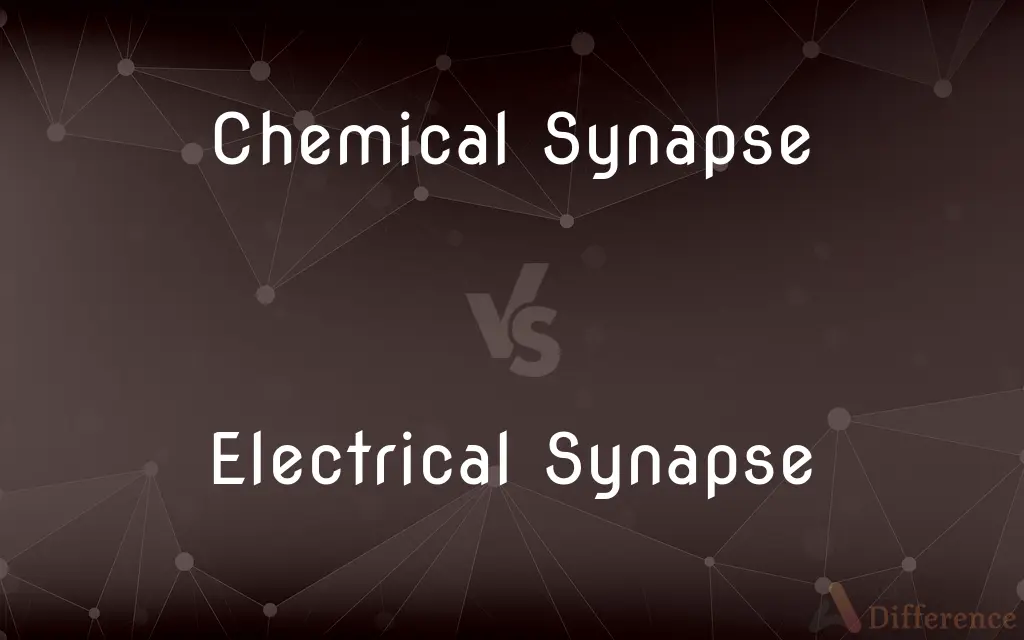Chemical Synapse vs. Electrical Synapse — What's the Difference?
Edited by Tayyaba Rehman — By Fiza Rafique — Published on December 3, 2023
A Chemical Synapse transmits signals using neurotransmitters, whereas an Electrical Synapse uses direct electrical conductance through gap junctions.

Difference Between Chemical Synapse and Electrical Synapse
Table of Contents
ADVERTISEMENT
Key Differences
Chemical Synapse and Electrical Synapse are both specialized structures facilitating communication between neurons. The Chemical Synapse employs chemicals called neurotransmitters to transmit information from one neuron to another. These neurotransmitters travel across a tiny space, called the synaptic cleft, to bind with receptor sites on the receiving neuron, initiating or inhibiting a new electrical signal.
In contrast, an Electrical Synapse uses gap junctions to allow direct electrical communication between adjacent neurons. These gap junctions are made up of protein channels that permit ions to pass freely between cells, enabling the quick transfer of electrical signals. Because of this direct connection, Electrical Synapses are faster than their chemical counterparts.
While the Chemical Synapse provides a more selective and modifiable means of communication, allowing for the intricate processing and modulation of signals, the Electrical Synapse offers rapid and synchronized activity. This makes Electrical Synapses particularly essential in certain reflexes and synchronized activities like heartbeat.
A notable difference between the Chemical Synapse and the Electrical Synapse is plasticity. Chemical Synapses exhibit plasticity, meaning their strength and efficiency can change over time based on activity, which is fundamental for learning and memory. On the other hand, Electrical Synapses are generally more consistent in their function.
Comparison Chart
Transmission Method
Uses neurotransmitters
Direct electrical conductance
ADVERTISEMENT
Structural Feature
Synaptic cleft
Gap junctions
Speed
Slower due to chemical transmission
Faster due to direct electrical connection
Plasticity
Exhibits plasticity (modifiable)
Generally consistent
Role in Neural Function
Allows intricate processing and modulation of signals
Enables rapid, synchronized activity
Compare with Definitions
Chemical Synapse
Selective and modifiable communication.
The Chemical Synapse provides refined signal transmission, enabling complex neural functions.
Electrical Synapse
Typically consistent in function without modifiability.
Unlike Chemical Synapses, Electrical Synapses remain relatively constant over time.
Chemical Synapse
Exhibits plasticity, allowing for modulation.
The strength of a Chemical Synapse can change over time, influencing learning.
Electrical Synapse
Characterized by gap junctions.
Gap junctions in an Electrical Synapse allow ions to flow directly between neurons.
Chemical Synapse
A junction between two nerve cells using neurotransmitters.
At the Chemical Synapse, neurotransmitters like dopamine can influence mood.
Electrical Synapse
Ensures synchronized activity in neural networks.
Electrical Synapses play a crucial role in maintaining a regular heartbeat.
Chemical Synapse
Functions slower than electrical synapses due to chemical processes.
The time it takes neurotransmitters to cross the cleft causes the Chemical Synapse to be slower.
Electrical Synapse
Uses direct electrical connections for signal transmission.
The heart's synchronized contractions are aided by Electrical Synapses.
Chemical Synapse
Features a synaptic cleft.
Neurotransmitters must cross the synaptic cleft in a Chemical Synapse.
Electrical Synapse
Offers rapid communication between adjacent neurons.
Reflex actions often employ Electrical Synapses due to their speed.
Common Curiosities
What do Electrical Synapses use for direct communication?
Electrical Synapses use gap junctions, enabling direct electrical communication between neurons.
Why are Chemical Synapses crucial for learning and memory?
Their plasticity allows for changes in strength and efficiency based on activity, facilitating learning and memory.
Which is faster, a Chemical Synapse or an Electrical Synapse?
An Electrical Synapse is faster due to its direct electrical connection.
Can Electrical Synapses be modified like Chemical Synapses?
Typically, Electrical Synapses are more consistent in function and don't exhibit the same plasticity as Chemical Synapses.
How do Electrical Synapses aid in reflex actions?
Their rapid transmission speed enables quick response times, which is vital for reflexes.
Can the strength of a Chemical Synapse change over time?
Yes, Chemical Synapses exhibit plasticity, allowing their strength and efficiency to change based on activity.
What is the small space called in a Chemical Synapse?
It's called the synaptic cleft.
Are there drugs that influence the function of Chemical Synapses?
Yes, many drugs, including antidepressants, influence neurotransmitter activity at Chemical Synapses.
Are Electrical Synapses common in the human brain?
While present, Electrical Synapses are less common than Chemical Synapses in the human brain.
Do Electrical Synapses play a role in synchronized neural activity?
Yes, Electrical Synapses ensure rapid and synchronized activity, vital in functions like maintaining a steady heartbeat.
What role do neurotransmitters play in Chemical Synapses?
In Chemical Synapses, neurotransmitters transmit information from one neuron to another across the synaptic cleft.
What's the main component that travels across a Chemical Synapse?
Neurotransmitters are the primary chemicals that travel across a Chemical Synapse.
Can diseases affect Chemical Synapses?
Yes, disorders like Alzheimer's can impact the functioning of Chemical Synapses.
Do all nerve cells communicate through Chemical Synapses?
No, while Chemical Synapses are common, some nerve cells also communicate through Electrical Synapses.
Share Your Discovery

Previous Comparison
Section in Law vs. Clause in Law
Next Comparison
Decadent vs. DegenerateAuthor Spotlight
Written by
Fiza RafiqueFiza Rafique is a skilled content writer at AskDifference.com, where she meticulously refines and enhances written pieces. Drawing from her vast editorial expertise, Fiza ensures clarity, accuracy, and precision in every article. Passionate about language, she continually seeks to elevate the quality of content for readers worldwide.
Edited by
Tayyaba RehmanTayyaba Rehman is a distinguished writer, currently serving as a primary contributor to askdifference.com. As a researcher in semantics and etymology, Tayyaba's passion for the complexity of languages and their distinctions has found a perfect home on the platform. Tayyaba delves into the intricacies of language, distinguishing between commonly confused words and phrases, thereby providing clarity for readers worldwide.
















































